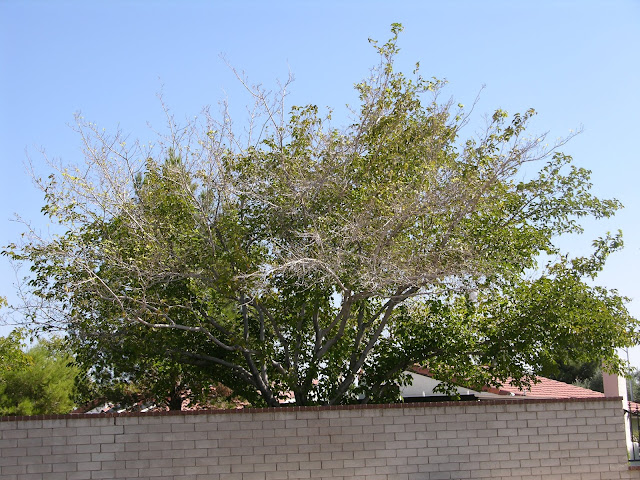Q.
What is causing the “big hurt” on mulberry trees? There was considerable damage
to most trees in recent years. What caused so many dead branches this and last
year?
What is causing the “big hurt” on mulberry trees? There was considerable damage
to most trees in recent years. What caused so many dead branches this and last
year?
 |
| Sooty canker disease |
A.
Mulberries are solid performers in the hot desert if they get enough water and are
pruned properly. I am not endorsing their planting; they use a lot of water and
the male trees release large amounts of allergenic pollen, a huge health problem
for many residents.
Mulberries are solid performers in the hot desert if they get enough water and are
pruned properly. I am not endorsing their planting; they use a lot of water and
the male trees release large amounts of allergenic pollen, a huge health problem
for many residents.
Battle of the Sexes
The female trees are not “outlawed”
in southern Nevada. The male, or fruitless mulberries, are. Female trees can be
planted and will produce fruit without male trees because of large amount of
airborne pollen produced every year from existing male trees.
in southern Nevada. The male, or fruitless mulberries, are. Female trees can be
planted and will produce fruit without male trees because of large amount of
airborne pollen produced every year from existing male trees.
 |
| Bowl of purple and white mulberry fruit in Tajikistan. Many countries I visited call the fruit “toots”. |
Sooty Canker Disease
We see an increasing number of
mulberries with dead branches in the tops of the trees. Most of this is “sooty
canker” disease. This fungal disease spreads from tree to tree on poorly
sanitized pruning equipment, birds and insects.
mulberries with dead branches in the tops of the trees. Most of this is “sooty
canker” disease. This fungal disease spreads from tree to tree on poorly
sanitized pruning equipment, birds and insects.
 |
| Sooty canker disease on ash. Looks the same on mulberry. |
It also infects other trees besides
mulberry including ash, poplar, apple and many others. Frequently, the health
of infected trees was “compromised” in some way making them susceptible to an
otherwise weak pathogen.
mulberry including ash, poplar, apple and many others. Frequently, the health
of infected trees was “compromised” in some way making them susceptible to an
otherwise weak pathogen.
What compromises the immunity of otherwise
vigorous trees growing the desert? Usually its water; a lack of it causing them
to be stressed. The disease organism is transported to this weakened tree on
pruning tools, or perhaps by birds or insects. This pathogen enters the tree
through open wounds caused by pruning equipment, fresh openings left by
dropping leaves, or through the flowers.
vigorous trees growing the desert? Usually its water; a lack of it causing them
to be stressed. The disease organism is transported to this weakened tree on
pruning tools, or perhaps by birds or insects. This pathogen enters the tree
through open wounds caused by pruning equipment, fresh openings left by
dropping leaves, or through the flowers.
Consider this scenario:
 |
| Sanitize pruning equipment before pruning |
a landscape
converts from large, established trees and lawns to a desert landscape; the
lawn is removed and drip irrigation is installed; large established trees do
not get enough water and limbs begin dying; landscapers remove limbs with
unsanitary tools; the trees become infected; disease spreads because the tree’s
health is compromised due to a lack of water.
converts from large, established trees and lawns to a desert landscape; the
lawn is removed and drip irrigation is installed; large established trees do
not get enough water and limbs begin dying; landscapers remove limbs with
unsanitary tools; the trees become infected; disease spreads because the tree’s
health is compromised due to a lack of water.
Simple solution? Sanitize pruning
equipment.
What a great community resource this is! Bravo�� Thanks for the free help tips. So many questions about my Trees and plants have been answered just in the past few days, that I have been seeking for the last nine months!
Sincerely, Larren